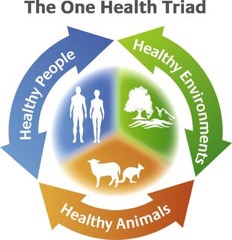The following post is one of a series previewing the research that will be presented at the SETAC North America 42nd Annual Meeting (SciCon4), 14–18 November.
A guest post by Lauren Gillespie, Central Community College-Columbus
I teach general biology at – (CCC-C) in Nebraska, where I hold ecology lab courses at a nearby creek with students in waders performing water quality tests. This “creek” is a glorified agricultural drainage ditch, bordered by farmland in a state that crop-dusts on a regular basis throughout the summer months. I saw birds nesting underneath the bridge once and decided on a whim to mist net during a lab session. Mist nets are used to capture birds and can only be purchased with proof of a U.S. Fish and Wildlife collecting permit. As students took samples, I extracted the bird—a barn swallow (photo 1, A)—that started this project.
Continue reading



 What is “One Health”?
What is “One Health”?